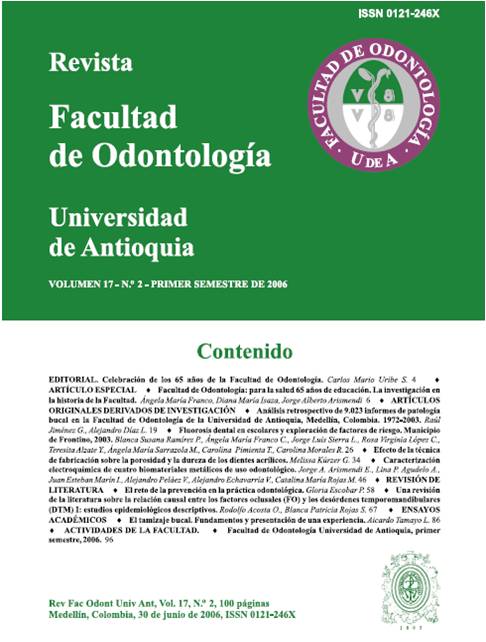Fluorosis dental en escolares y exploración de factores de riesgo: municipio de Frontino, 2003
DOI:
https://doi.org/10.17533/udea.rfo.3165Palabras clave:
fluorosis dental, caries dental, escolaresResumen
Los objetivos de la investigación fueron: 1) determinar la prevalencia y distribución de la fluorosis dental en escolares de 8-12 y 15 años de edad del municipio de Frontino, 2) explorar el comportamiento de los factores de riesgo asociados con fluorosis (concentración de flúor en agua, sal y cremas dentales). La fluorosis se evalúo en una muestra representativa de 810 escolares, distribuidos en 4 estratos geográficos de acuerdo con el conocimiento previo sobre casos de fluorosis reportados; para la clasificación de los hallazgos clínicos se utilizó el índice de Thylstrup y Fejerskov (TFI). Las muestras de agua recolectadas (33) de las fuentes más reconocidas por los pobladores rurales y urbanos, así como las muestras de sal (48), fueron analizadas mediante el método directo y las de crema dental (27) mediante el método de microdifusión (HMDS). La prevalencia de fluorosis dental fue del 67%, siendo los grados 1-3 los más frecuentes. Las concentraciones de flúor en todas las muestras de agua estuvieron por debajo de 0,05 mg/L. El 60,4% de las muestras de sal recolectadas en hogares y expendios del municipio, no cumplía con la norma sobre concentración de flúor establecida en Colombia. La concentración promedio de flúor en las muestras de crema dental fue de 1.504 + 387 ppm. Se concluye que el problema de fluorosis se explica por una ingesta múltiple de flúor proveniente de la sal de cocina y de las cremas dentales. Se requiere vigilancia permanente del programa de fluoruración de sal y educación a la comunidad y a los profesionales para la correcta utilización de los productos fluorurados.
Descargas
Descargas
Publicado
Cómo citar
Número
Sección
Licencia
El Derecho de autor comprende los derechos morales y los derechos patrimoniales.
1. Los derechos morales: nacen en el momento de la creación de la obra, sin necesidad de registro. Corresponden al autor de manera personal e irrenunciable; además, son imprescriptibles, inembargables y no negociables. Son derechos morales el derecho a la paternidad de la obra, el derecho a la integridad de la obra, el derecho a conservar la obra inédita o publicarla bajo seudónimo o anónimamente, el derecho a modificar la obra, el derecho al arrepentimiento, y el derecho a la mención, según definiciones consignadas en el artículo 40 del Estatuto de propiedad intelectual de la Universidad de Antioquia (RESOLUCIÓN RECTORAL 21231 de 2005).
2. Los derechos patrimoniales: consisten en la facultad de disponer y aprovecharse económicamente de la obra por cualquier medio. Además, las facultades patrimoniales son renunciables, embargables, prescriptibles, temporales y transmisibles, y se causan con la publicación, o con la divulgación de la obra. Para el efecto de la publicación de artículos de la Revista de la Facultad de Odontología se entiende que la Universidad de Antioquia es portadora de los derechos patrimoniales del contenido de la publicación.
Yo, el(los) autor(es), y por mi(nuestro) intermedio, la Entidad para la que estoy(estamos) trabajando, transfiero(imos) de manera definitiva, total y sin limitación alguna a la Revista Facultad de Odontología Universidad de Antioquia, los derechos patrimoniales que le corresponden sobre el artículo presentado para ser publicado tanto física como digitalmente. Declaro(amos) además que este artículo ni parte de él ha sido publicado en otra revista.
Política de Acceso Abierto
Esta revista provee acceso libre inmediato a su contenido, bajo el principio de que poner la investigación a disposición del público de manera gratuita contribuye a un mayor intercambio de conocimiento global.
Licencia Creative Commons
La Revista facilita sus contenidos a terceros sin mediar para ello ningún tipo de contraprestación económica o embargo sobre los artículos. Para ello adopta el modelo de contrato de licenciamiento de la organización Creative Commons denominada Atribución – No comercial – Compartir igual (BY-NC-SA). Esta licencia les permite a otras partes distribuir, remezclar, retocar y crear a partir de la obra de modo no comercial, siempre y cuando nos den crédito y licencien sus nuevas creaciones bajo las mismas condiciones.
Esta obra está bajo una Licencia Creative Commons Atribución-NoComercial-CompartirIgual 4.0 Internacional.














